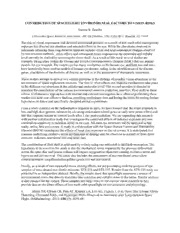
NASA Technical Reports Server (NTRS) 20110023077: Contribution of Spaceflight Environmental Factors to Vision Risks PDF
Preview NASA Technical Reports Server (NTRS) 20110023077: Contribution of Spaceflight Environmental Factors to Vision Risks
CONTRIBUTION OF SPACEFLIGHT ENVIRONMENTAL FACTORS TO VISION RISKS Susana B. Zanello Universities Space Research Association, JSC-SK Division, 2101 NASA Rd 1, Houston, TX 77058 The risk of visual impairment and elevated intracranial pressure as a result of low-earth orbit microgravity exposure has directed our attention and research efforts to the eye. While the alterations observed in astronauts returning from long duration missions include vision and neuroanatomical changes observed by non-invasive methods1, other effects and subsequent tissue responses at the molecular and cellular level can only be studied by accessing the tissue itself. As a result of this need, several studies are currently taking place within the Human and Health Countermeasures Element (HHC) that use animal models for eye research. The rodent eye has many similarities to the human eye, and both rats and mice have historically been used as models of human eye disease, aiding in the identification of the disease genes, elucidation of mechanisms of disease, as well as in the assessment of therapeutic treatments. These studies attempt to answer two central questions in the etiology of possible vision alterations in the environment of space exploration missions. The first is: what effects and response mechanisms take place in the different eye structures at the cellular and molecular level? The second question is directed to elucidate the contribution of the various environmental stressors (radiation, nutrition, fluid shift) to these effects. Collaborative approaches with internal and external investigators have allowed performing these studies in a most cost-effective fashion, providing preliminary data and laying the bases for testing further hypotheses in future and specifically designed animal experiments. From a study centered on the radioadaptive response in mice, we have learned that the retina responds to low and high dose gamma radiation by elevating antioxidant-related genes at early time points (4hrs) and that this response returns to control levels after 1 day post-irradiation. We are expanding this research with another collaborative study that investigates the combined effects of radiation exposure and iron overload on sensitivity to radiation injury in rat eyes. All main eye structures will be analyzed in this study: retina, lens and cornea. A study in collaboration with the Space Human Factors and Habitability Element (SHFH) investigates the effects of lunar dust exposure on the rat cornea. It is anticipated that common underlying oxidative stress mechanisms of damage may be observed as a result of these three stressors: radiation, nutritional iron and lunar dust. The contribution of fluid shift is addressed by a study using rats subjected to hindlimb suspension. The hypothesis to be tested in this study is that the mechanical stress imparted by the pressure differential across the optic disc and lamina cribosa will impact oxygenation (therefore causing oxidative stress and hypoxia) and cell survival. This study also includes the assessment of two nutritional antioxidant countermeasures: epigallocatechin gallate (green tea) and resveratrol. Finally, as a result of two successful tissue sharing efforts, we are proceeding with the analysis of eye samples of mice aboard two shuttle missions: STS-133 and STS-135. Results from the STS-133 study are presented in an independent abstract. Briefly, the results show that spaceflight represents a source of environmental stress that directly translates into oxidative and cellular stress in the retina. Similar analysis is also planned for the cornea. These samples add large value to our current vision research as they provide data on the direct effects of low-earth orbit spaceflight on eye structures and physiology. 1. Mader TH, Gibson CR, Pass AF, Kramer LA, Lee AG, Fogarty J, et al. Optic Disc Edema, Globe Flattening, Choroidal Folds, and Hyperopic Shifts Observed in Astronauts after Long-duration Space Flight. Ophthalmology. 2011; 118(10): 2058-69.
